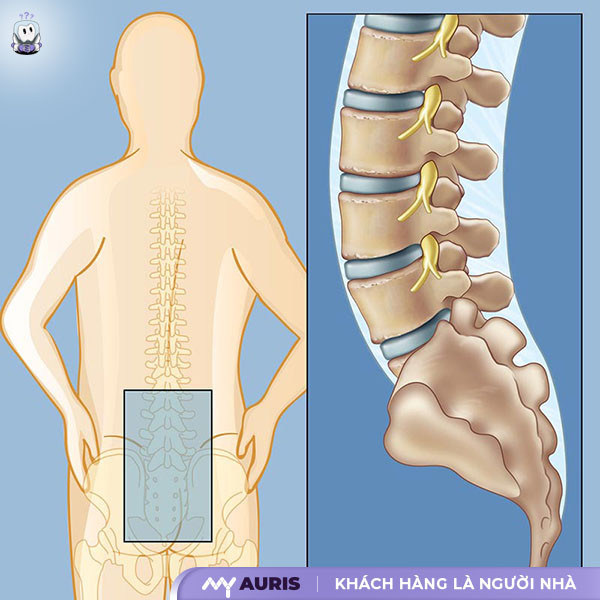Back pain is a common health issue, often appearing after strenuous labor, incorrect posture, or minor injuries. However, few people know that in many cases, back pain is not just a feeling of fatigue but can also be an early sign of serious underlying conditions related to the spine, intervertebral discs, or the sciatic nerve.
So, how can one differentiate dangerous types of back pain and find appropriate treatment? The following information will help you understand more clearly and proactively protect your own health.
What is Back Pain?
What is back pain – it is a common condition that can affect millions of people globally, causing prolonged discomfort in the area along or near the spine. This condition not only causes physical fatigue but also reduces the quality of life if not detected and treated promptly.
Depending on the case, back pain manifests in various areas such as the upper back, mid-back, lower back, or even just on one side of the back (right or left). Understanding the specific location of the pain will help doctors diagnose and treat the underlying cause more effectively, thereby shortening the recovery time for the patient.
Medically, the back pain experienced is typically classified into two main types:
- Acute back pain: This condition appears suddenly and can last up to six weeks. The pain is usually intense and distinct, sometimes as a result of injury or incorrect movement.
- Chronic back pain: Develops over a longer period, possibly exceeding three months. This type is often persistent, dull, prone to recurrence, and can be associated with serious underlying medical conditions.
The sensation of back pain varies depending on the cause, ranging from a persistent dull ache to severe throbbing pain, often accompanied by a burning sensation. Particularly, the pain can radiate down to the limbs, leading to numbness or muscle weakness, directly affecting daily movement and activities.

Identifying Dangerous Back Pain Locations
Back pain is a common issue affecting all ages and is often underestimated. However, it’s not merely fatigue from physical activity; back pain can be a warning sign of underlying health problems that should not be ignored. Understanding dangerous back pain locations and associated risks will help in early detection and prevention of serious conditions.
Low Back Pain
Low back pain, typically affecting the lower back region, is one of the common signs influenced by lifestyle or occupational habits. The pain can radiate down the leg, accompanied by numbness, signaling conditions such as herniated disc, spinal degeneration, or an intra-spinal tumor.
Upper Back Pain
Located between the neck and below the chest, upper back pain is often related to injury, overuse, or posture problems. If upper back pain is persistent, you should be cautious as it could be a manifestation of underlying conditions such as osteoarthritis, herniated disc, or even lung cancer – a condition requiring timely medical care.
Lower Back Pain
Lower back pain often arises from injury or sudden movements. However, this condition can also be an alarming sign of dangerous diseases such as spinal stenosis, disc injury, or ovarian cysts in women.
Right Back Pain
Pain on the right side of the lower back near the waist, near the buttocks, or on the right shoulder blade is one of the dangerous back pain locations that requires attention. Right back pain symptoms are clear, often presenting as a dull ache as if compressed by a heavy object, or intense pain appearing suddenly. Patients may find it difficult to twist or bend their bodies, and the pain can radiate to surrounding areas.
Causes may include:
- Injuries such as sprains, muscle strains;
- Conditions like spinal stenosis, herniated disc, spinal degeneration;
- Cauda equina syndrome, appendicitis, kidney stones, or ulcerative colitis.
Left Back Pain
Similar to right-sided pain, left back pain can also be caused by muscle strain or arthritis. But if accompanied by symptoms such as frequent urination or blood in the urine, it could be a sign of kidney diseases like glomerulonephritis or kidney stones – requiring immediate medical intervention to avoid dangerous complications.
Widespread Back Pain
If you experience pain throughout your back, whether in the upper, lower, left, right, or lumbar region, this is a worrying symptom. In many cases, this condition can be a sign of neurological disorders, diffuse spinal conditions, or systemic arthritis – all of which should not be ignored.

Common Solutions for Back Pain
Back pain is a common ailment that almost everyone experiences at some point in their lives. For some, it’s a minor inconvenience, but in other cases, certain back pain positions can be a warning sign of serious underlying health issues. Identifying the location, nature, and severity of the pain plays a crucial role in accurate diagnosis and effective resolution of this condition.
Mild Cases
For mild back pain, you can apply home remedies such as adequate rest, hot or cold compresses, along with over-the-counter pain relievers to help alleviate pain and discomfort. However, it’s important to balance rest with gentle exercise to prevent muscle stiffness and weakness, while maintaining musculoskeletal health.
Severe or Persistent Back Pain
For cases of persistent back pain, especially in dangerous back pain locations or with severe intensity, it is advisable to promptly consult a doctor for specialized medical treatment. In such instances, prescription pain medications will be used to manage discomfort. Additionally, antidepressants may be prescribed to help relax muscles and reduce associated symptoms. In some situations, doctors may consider Cortisone injections to reduce inflammation and improve the pain condition.
Physical Therapy
Physical therapy is a common and proven treatment method that helps strengthen muscles, improve flexibility, and correct posture to enhance spinal health and reduce pain over time. Patients should develop a suitable exercise regimen under the guidance of trained specialists to maximize effectiveness and ensure safety throughout the therapy process.
Alternative Therapies
In addition to conventional treatments, patients may supplement with several alternative therapies such as laser therapy, infrared therapy, or specialized diagnostic procedures to further manage pain. These methods should be integrated into a comprehensive treatment plan, under the guidance of a specialist doctor, to achieve the best results.
Surgical Treatment
When all the aforementioned treatment measures fail to relieve pain, or when patients suffer from conditions such as back pain due to herniated discs, spinal degeneration, or cauda equina compression, surgical intervention is a last but necessary option. The goal of surgical treatment is to address the underlying cause of pain, prevent more severe complications, thereby providing long-term pain relief and improving the patient’s quality of life.
Understanding the causes of back pain, identifying dangerous back pain locations, and applying effective remedies will help you quickly control symptoms and maintain a healthy life. You should not be negligent when experiencing back pain; consult a doctor and follow their advice to avoid prolonged complications.





